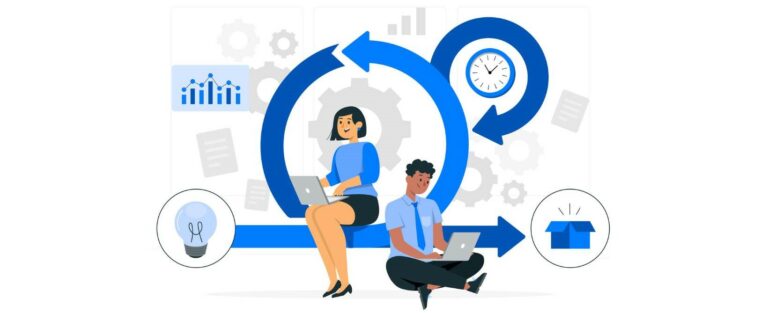Finding the right tools and technologies for your business is like building your dream playlist. Each song flows perfectly into the next, and getting through the day is a bit easier with your favourite songs.
A successful digital transformation means your business flows like the perfect playlist. Every person, process, and technology links up, so you spend less time repeating tasks and more time focusing on the things that matter in your business.
But getting to that stage takes work. You’re not just switching out old tools – you’re switching out old ways of thinking. In this guide, we take you through the key aspects of digital transformation for SMEs. Let’s get into it.

Establishing clear objectives and planning
A successful digital transformation starts with clear, achievable goals and a detailed plan. It’s easy to get swept up in new tools and software; chasing novel technologies without considering their impact on your people, customers, and bottom line. Just like the race to embrace AI, you might find new tools and systems interesting, but connecting them to tangible business benefits is what matters most.
First: identify what you want from a digital transformation. Do you want to simplify processes for employees, to help them become more efficient? Do you want to understand your customers better, so you can deliver targeted advertising and secure more sales? Maybe it’s a combination of things.
Answering questions like these will allow you to work backwards from the end goal, and develop a step-by-step plan that gets you there. Having a clear set of objectives also means you have something to measure. Unless you can track what you’re building, you won’t be able to determine whether your strategy is a success. Trackable, measurable goals allow you to course correct when things don’t go to plan.
Many SMEs will understand the challenge of constrained resources and budgets, and we’ve created a guide to help SMEs manage their digital transformation budget. Consider your objectives as a tool for managing this; they help you devote resources to the right places and minimise waste. If you’re focusing on customer retention, divert your resources to customer-focused platforms and processes.
The planning process is also an opportunity to identify risks. Breaking down your plan into phases, you can consult with specific departments and teams to spot risks upfront. Meaning, you can develop mitigation strategies ahead of time – reducing the chances of your project going off the rails.
The best strategies are detailed – but not fixed. Be open to changes down the line; as your business bends, adapts, and grows, so too will your strategy. Continue to evaluate the effectiveness of your plan against your original goals and motives, using data. More on that later.

Leadership commitment
Great leadership underpins every digital transformation project. Leaders help to bring the strategy and objectives to life for teams, breaking them down into daily tasks and habits that take you closer to the end goal.
Digital transformation often triggers cultural change; as new software and systems come into place, employees must adapt to new ways of working. Having leaders who can act as ambassadors for the project, by providing support and encouraging engagement, is essential.
Don’t forget to train and support your leaders with the changes, too. They’ll be responsible for implementing the digital transformation strategy at team level, so you’ll want to provide ongoing guidance that builds their confidence and competence.
Having committed and engaged leaders also means they’ll help you spot opportunities for more team training. Their close proximity to teams will help you understand the effectiveness of your digital transformation – so seek their thoughts and ideas frequently.

Change management
There’s no getting away from it: digital transformation means embracing change. This change can be overwhelming for your teams that may not be familiar with the technologies and processes you’re implementing.
Adopting change management practices can help you work through resistance and clear up any ambiguity about the project for employees. Clear communication is essential – perhaps in the early stages of your project, you could host forums with departments and teams to unpack concerns and overcome resistance.
Choosing to be transparent with employees about your digital transformation helps build acceptance too. People are more likely to engage with new technologies and processes if they understand them, and your intentions behind implementing them. Transparency, as a general rule, will help you maintain a healthy culture throughout the transformation – so the digital transformation is done with your team, not to your team.
Poorly managed change is disruptive. A badly integrated tool can create delays where it was supposed to speed things up. In the UK, Birmingham City Council have faced immense pressure to resolve issues with its Oracle Cloud system. Payments that should be sent automatically are being handled manually, as are safeguarding checks. The challenges have cost the council time, and more than doubled the original project budget of £19 million.
Meanwhile, Spar Retail Group suffered a near-50% drop in annual operating profit, following a failed IT system implementation that disrupted distribution operations in South Africa.
Be clear and transparent about your digital transformation. It’ll help you break down silos and foster collaboration between employees, who will be able to find a sense of unity in the project.

Skill development
At some point, you’re going to discover missing skills. Developing new skills is aSkill a necessary part of digital transformation, and can be the determining factor in the success of a project. Training builds confidence, enabling teams to be more experimental and innovative in their use of new tools.
Bringing digital literacy levels up can make it easier for teams to collaborate and understand each other, too. Keep an eye out for government-funded programmes and initiatives to boost digital skills, and explore the options available through your software providers. Many modern platforms offer free and paid training to help you and your people get up to speed.
You’ll also need to identify technology-specific skills your teams need – for example, training for a specific software platform. As well as the process-specific skills your people need – such as learning data analytics and interpretation.
The adoption of new tools and systems can leave you open to security threats if people are unprepared. Having a well-trained team will help you keep company and customer data safe, as well as supporting compliance with data regulations. If your employees are on the frontline between your business and cyberattacks, you’ll want them to be fully equipped.
It’s important to remember that today’s technology isn’t static. Many software packages are updated throughout their lifecycle, and regular training is an important factor in making sure you get the best from your tools. In some circumstances, you’ll need to hire new digital skills into your business. If you’ve spent enough time developing your strategy and objectives, you should be able to pinpoint when and where these skills are needed.

Customer centricity
Digital transformation is typically considered an internal project, but focusing on your customers will help you provide a better, more competitive service.
Aligning your digital transformation with customer needs, preferences, and expectations allows you to deliver a more personalised experience. Something that remains a top priority for customers.
Embracing digital tools and processes can also help you deliver these experiences. With access to real-time customer data – whether that’s through an e-commerce platform or customer data platform – can help you understand buyers on a deeper level. Making it easier to provide exactly what they want (before they know they want it).
Seamless customer experiences have a knock-on impact on brand loyalty. Customers no longer tolerate a glitchy chatbot that churns out the phrase ‘Sorry, I don’t understand’. Opt for user-friendly intuitive tools that provide a more human experience.
If your digital transformation goals include increased revenue and a bigger customer base, you’ll want to focus on tools and systems that smooth out the customer experience. Mapping out the customer journey can help you identify clunky processes and drop off points.
Be conscious too, of taking customer feedback onboard. Even if your digital transformation is internally-focused, there’s a good chance customers will feel the ripple effect of changing processes.

Data-driven decision-making
When you’re busy piecing together your digital transformation, data captures the parts of the story you missed.
Taking a data-driven approach to digital transformation will help you make better decisions, course correct promptly, and identify growth opportunities. For example, a new CRM system can tell you about customer purchase history – which you can monitor throughout your digital transformation.
Similarly, a smart HR system can give you a better sense of employee productivity and engagement. You can compare performance reviews over time, to see where feedback was actioned and opportunities for further development lie.
Data is essential for delivering personalised experiences and targeted improvements. Tracking a handful of specific data points that are important for your business – say, employee productivity and customer retention – you can tweak and adjust your digital strategy to make sure it’s working.
Over time, your data becomes more powerful. You can use historical data to make forecasts and predictions – say, using customer purchasing data to predict sales over the next six months. Data analytics can also support your risk management and fraud detection efforts. By analysing patterns and anomalies in financial transactions and operation data, you can spot potential risks, fraudulent activities, and security threats.
Being able to do so much with data hinges on understanding it. While you may choose to have one or two data specialists in your business, improving general awareness and understanding throughout the team matters too. Almost everyone in your business will have a touchpoint with new technology, and the data it captures.

Adaptability
Technologies are evolving – even the ones you’ve already implemented. So too are customer preferences, compliance obligations, market dynamics, and cyber threats. Monitoring different parts of your business, and calling on the data for insights, will help you keep up with the changes.
External factors such as market dynamics and economic indicators can also impact the success of your digital transformation. Regular monitoring, training, and conversations about technology can help you adapt to changes and align with broader economic and market conditions.
In time, you may outgrow the original tools and technologies you implemented as part of this transformation. Choosing solutions that are scalable and can grow with you is important, but replacing them at the right time is equally important. A tool fit for your first few years of transformation may need to be phased out as you grow – and regular monitoring enables this.
When you understand how to use data effectively, it can give you more confidence in your decision-making. This disperses to the wider team, who will benefit from assertive leadership in the face of change.
Remember – People, Process, and Technology. It might be a digital transformation, but the human transformation comes first.
Want to know more about delivering a successful digital transformation? We can simplify the complexities for you. Get in touch with one of our advisors today.



